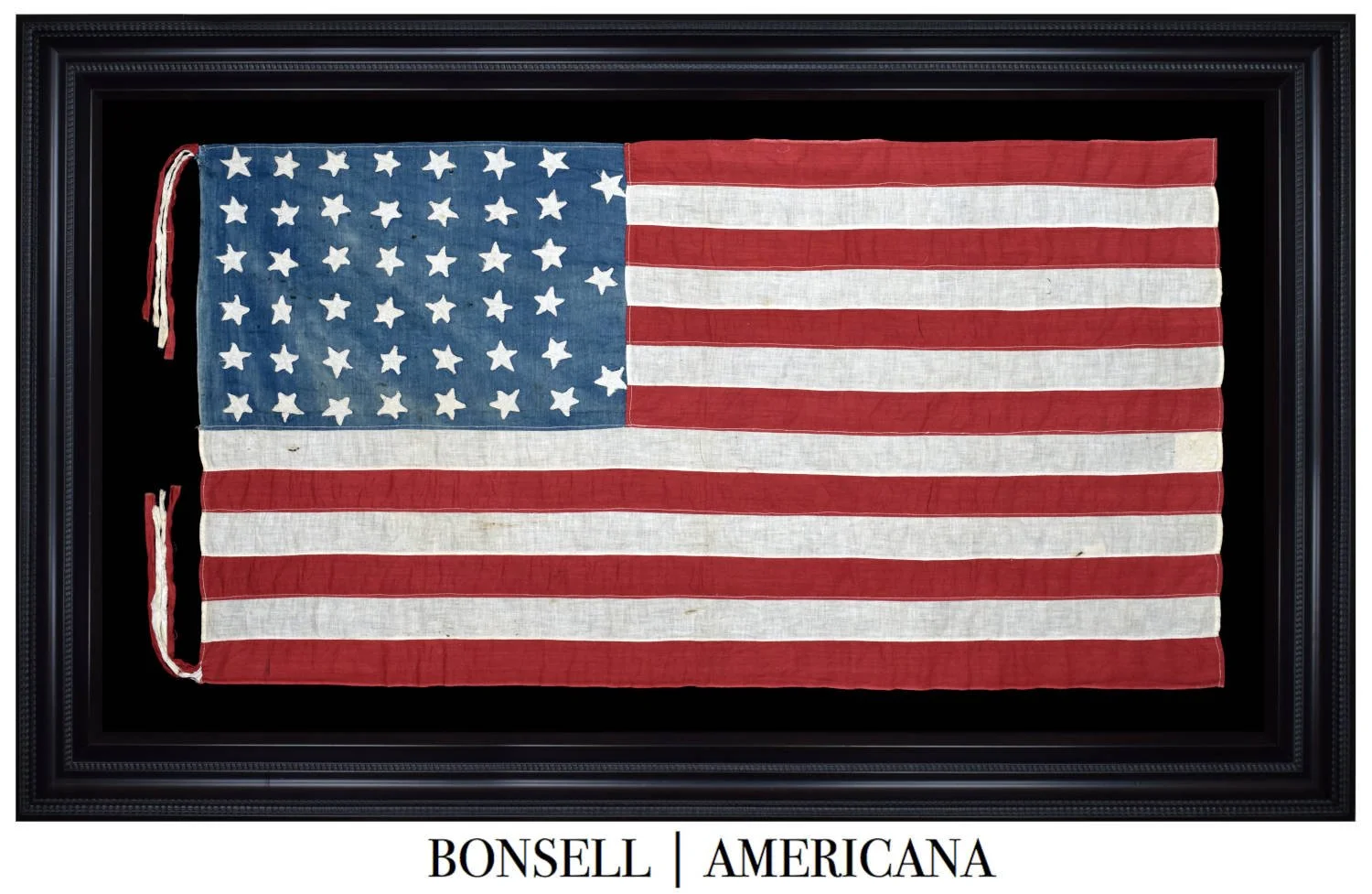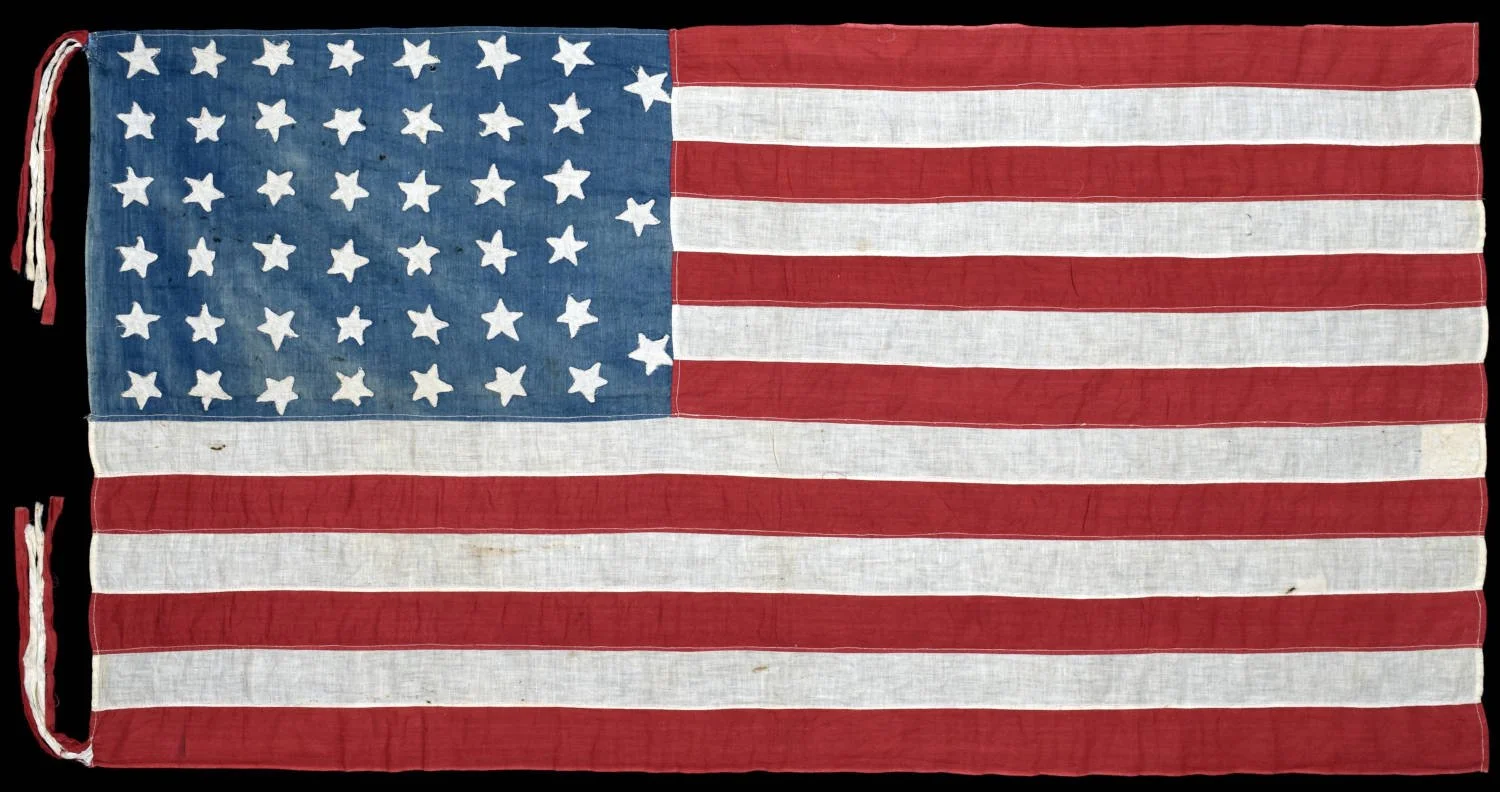45 Star Antique Flag with a Notched Star Configuration | An Attractive Homemade Example | Utah Statehood | Circa 1896-1907
45 Star Antique Flag with a Notched Star Configuration | An Attractive Homemade Example | Utah Statehood | Circa 1896-1907
Price: Please call 618-553-2291, or email info@bonsellamericana.com
Frame Size (H x L): 39” x 65.5”
Flag Size (H x L): 27” x 52” with 11” tassels
Offered is a homemade forty-five star flag. Homemade antique flags stand out in the realm of flag collecting, and for good reason. These flags—crafted with personal care by the hands of individuals, rather than mass-produced in factories—hold a unique story and have character. Every stitch, imperfection, and design choice speaks to the time, place, and the person who created it. Unlike their mass-produced counterparts, homemade flags often carry with them the emotions, hopes, and spirit of the times they were made in. This intimate connection to history, combined with their one-of-a-kind nature, makes homemade antique flags a treasure for collectors and enthusiasts alike.
The flag offered herein is made entirely of cotton. Its stripes are individually cut and machine sewn together, and they are similarly machine sewn to the cornflower blue canton. The stars of this flag are made of cotton, and they are machine sewn to both sides of the canton (i.e., double appliqued). The top of the hoist edge includes two white tassels and two red tassels. Similarly, the bottom also includes two white tassels and two red tassels.
The allure of an antique flag often hinges on its size. Overly large flags can bring about challenges, from the intricacies of framing to the complexities of shipping, deterring many potential collectors. On the other end of the spectrum, flags that are too small can miss out on the "wow factor", failing to leave a lasting impression. The flag offered herein is a piece that embodies the perfect balance in size. Neither too big nor too small, it captures the essence of history while being both manageable and impressively captivating. This ideal size ensures that it can be appreciated and showcased with ease, placing it at the pinnacle of desirability in amongst antique flags.
The First Flag Act of 1777 specified the number of stripes and the colors of the flag, but it did not specify the star placements or its overall proportions. Because of this lack of specificity, each flag maker could place the stars and dimension the flag however he wanted. This freedom extended all the way to 1912, the time at which President Taft issued Executive Order 1556, establishing that the stars should be placed in a rectilinear pattern, and the proportions of the flag. In the case of this early flag, the stars are arranged in a 7-1-7-7-1-7-7-1-7 pattern, with notches in the right hand column. The notches represent the openings for the next three states to be admitted to the union: Oklahoma, Arizona, and New Mexico.
FORTY-FIVE STAR FLAGS GENERALLY
The forty-five star flag represents the inclusion of Utah to the Union. Utah was admitted on January 4th, 1896, and this flag became official on July 4th, 1896. Presidents Grover Cleveland, William McKinley, and Teddy Roosevelt served under this flag, and the Spanish-American War was fought under it.
In 1848 Utah became a territory of the United States, and in 1849 its constitution was established as the Mormon State of Deseret. The next year, the State of Deseret applied to become a state, but Congress rejected the application and changed its name to the Utah Territory, which included the entirety of Nevada and portions of Colorado and Wyoming (as a section of the Missouri Compromise). Despite its continued efforts to gain statehood, it remained a territory, partially as a result of the Mormon Church and Utah authorities being openly tolerant of polygamy. In 1890 Utah outlawed the practice, and in 1896 Utah finally became the forty-fifth state.
The forty-five star flag was official for 12 years up until July 4th, 1908, when the forty-six star flag became official and began to represent the inclusion of Oklahoma in the Union.
Conservation Process: This flag was hand sewn to cotton fabric, and both were hand sewn to a mounting board. To prevent the black dye in the cotton fabric from seeping into the flag, it was first washed in a standard wash and then in a dye setting wash. The flag is positioned behind Optium Museum Acrylic.
Frame: This offering is in a modern black frame. Portions of its profile are smooth; other portions are rippled.
Condition Report: The canton has faded slightly, more so in some places than in others. There are some small stains, the most notable of which are on the white stripes. There are a few small tears and holes. Overall, this flag is attractive and age appropriate.
Collectability Level: The Great – Perfect for Rising Collectors
Date of Origin: 1896-1907
Number of Stars: 45
Associated War: The Spanish-American War (1898)
Associated State: Utah











